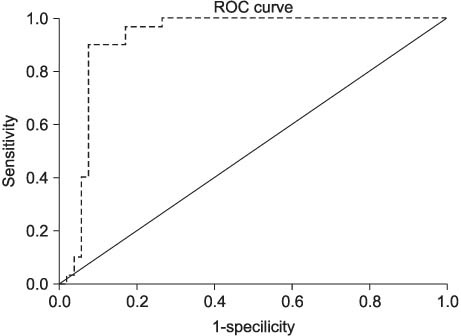Korean J Urol.
2006 Sep;47(9):958-962. 10.4111/kju.2006.47.9.958.
The Significance of Prostate-specific Antigen after Transrectal Prostate Biopsy
- Affiliations
-
- 1Department of Urology, Fatima Hospital, Daegu, Korea. uropone@yahoo.co.kr
- 2Department of Urology, Kyungpook National University School of Medicine, Daegu, Korea.
- KMID: 2294091
- DOI: http://doi.org/10.4111/kju.2006.47.9.958
Abstract
- Purpose
The serum prostate-specific antigen (PSA) level is increased after needle biopsy (Bx) of the prostate. This study tested the hypothesis that the prostate that harbors malignant lesions demonstrates less leakage of PSA after transrectal prostate Bx, and this phenomenon can be helpful in discriminating benign protrates from cancer ous prostrates.
Materials and Methods
Eighty three patients were included in this prospective study because they had an increase PSA level (from 4 to 30ng/ml) and/or an abnormal digital rectal examination, and the serum PSA level was checked 60 minutes later after biopsy. We checked the pre-Bx total serum PSA, the post-Bx total serum PSA and the PSA ratio (post-Bx total serum PSA to pre-Bx total serum PSA), and we analyzed the sensitivity, specificity, positive predictive value, negative predictive value and the statistical differences.
Results
Of the 31 men whose PSA ratio was less than 2.0, 27 (87%) men were proven to have prostate cancer. Of the 52 men whose PSA ratio was greater than 2.0, 49 (94%) were proven to have benign lesions. When setting 2.0 as the cutoff value, the difference was statistically significant (p<0.001); the sensitivity was 90.0%, the specificity 92.4%, the positive predictive value (PPV) 87.0% and the negative predictive value (NPV) 94.2%.
Conclusions
Evaluating the 1-hour PSA ratio might be helpful for clinicians to diagnosis the high risk patients who might have cancer in their prostate glands. Repeat biopsy should be considered for patients who initially had negative biopsy results with a smaller PSA ratio.
MeSH Terms
Figure
Reference
-
1. Oesterling JE. prostate-specific antigen: a critical assessment of the most useful tumor marker for adenocarcinoma of the prostate. J Urol. 1991. 145:907–923.2. Catalona WJ, Partin AW, Slawin KM, Brawer MK, Flanigan RC, Patel A, et al. Use of the percentage of free prostate-specific antigen to enhance differentiation of prostate cancer from benign prostatic disease: a prospective multicenter clinical trial. JAMA. 1998. 279:1542–1547.3. Lin TP, Huang WJ, Chen KK. Differentiation of benign prostatic hyperplasia from prostate cancer using prostate-specificfic antigen dynamic profile after transrectal prostate biopsy. J Urol. 2004. 171:2226–2229.4. Boring CC, Squires TS, Tong T, Montgomery S. Cancer statistics, 1994. CA Cancer J Clin. 1994. 44:7–26.5. Carter HB, Coffey DS. The prostate: an increasing medical problem. Prostate. 1990. 16:39–48.6. Wingo PA, Tong T, Bolden S. Cancer statistics, 1995. CA Cancer J Clin. 1995. 45:8–30.7. Cho IR, Chang YS, Roh JS, Jeon JS, Park SS. Change of PSA and PSAD after antibiotic treatment in patients with prostatitis. Korean J Androl. 2002. 20:100–105.8. Abe M, Hashimoto T, Matsuda T, Saitoh M, Watanabe H. Prostatic biopsy guided by transrectal ultrasonography using real-time linear scanner. Urology. 1987. 29:567–569.9. Devonec M, Fendler JP, Monsallier M, Mouriquand P, Mestas JL, Dutrieux-Berger N, et al. Prostatic cancer diagnosis with ultrasonically guided prostatic biopsy: results in 226 cases. Prog Clin Biol Res. 1989. 303:35–40.10. Wang MC, Valenzuela LA, Murphy GP, Chu TM. Purification of a human prostate-specific antigen. Invest Urol. 1979. 17:159–163.11. Catalona WJ, Richie JP, Ahmann FR, Hudson MA, Scardino PT, Flanigan RC, et al. Comparison of digital rectal examination and serum prostate-specific antigen in the early detection of prostate cancer: results of a multicenter clinical trial of 6,630 men. J Urol. 1994. 151:1283–1290.12. Lee SC, Lee SC, Kim WJ. Value of PSA density, PSA velocity and percent free PSA for detection of prostate cancer in patients with serum PSA 4-10ng/ml patients. Korean J Urol. 2004. 45:747–752.13. Carter HB, Pearson JD, Metter EJ, Chan DW, Andres R, Fozard JL, et al. Longitudinal evaluation of serum androgen levels in men with and without prostate cancer. Prostate. 1995. 27:25–31.14. Stenman UH, Hakama M, Knekt P, Aromaa A, Teppo L, Leinonen J. Serum concentrations of prostate-specific antigen and its complex with a1-antichymotrypsin before diagnosis of prostate cancer. Lancet. 1994. 344:1594–1598.15. Im YJ, Hong SJ, Chung BH. Clinical application of free to total PSA ratio in detection of prostate cancer in Korean men: lower cut-off value. Korean J Urol. 2004. 45:753–757.16. Mettlin C, Murphy GP, Lee F, Littrup PJ, Chesley A, Babaian R, et al. Characteristics of prostate cancer detected in the American Cancer Society-National Prostate Cancer Detection Project. J Urol. 1994. 152:1737–1740.17. Charrie A, Fleury-Goyon MC, Dutey P, Perrin P. The effect of prostate aspiration biopsy on serum levels of prostatic acid phosphatase and prostate-specific antigen. JAMA. 1986. 256:474.18. Lechevallier E, Echazarian C, Ortega JC, Daniel L, Roux F, Thirion X, et al. Kinetics of postbiopsy levels of serum free prostate-specific antigen and percent free prostate-specific antigen. Urology. 1999. 53:731–735.19. Mai KT, Moazin M, Morash C, Collins JP. Transitional zone and anterior peripheral zone of the prostate. A correlation of small-volume cancer in the biopsy cores and high psa with positive anterior margins in radical prostatectomy specimens. Urol Int. 2001. 66:191–196.20. Deliveliotis C, Varkarakis J, Albanis S, Argyropoulos V, Skolarikos A. Biopsies of the transitional zone of the prostate. Should it be done on a routine basis, when and why? Urol Int. 2002. 68:113–117.
- Full Text Links
- Actions
-
Cited
- CITED
-
- Close
- Share
- Similar articles
-
- Miliary Tuberculosis Following Transrectal Ultrasonography (TRUS)-Guided Prostate Biopsy
- Epidural Abscess on the Lumbosacral Area after Transrectal Ultrasonography Guided Prostate Needle Biopsy
- Localized Amyloidosis of the Prostate
- The Diagnostic Value of Prostate-specific Antigen and the of Routine Laboratory Examination for Early Detection
- Radical Prostatectomy


